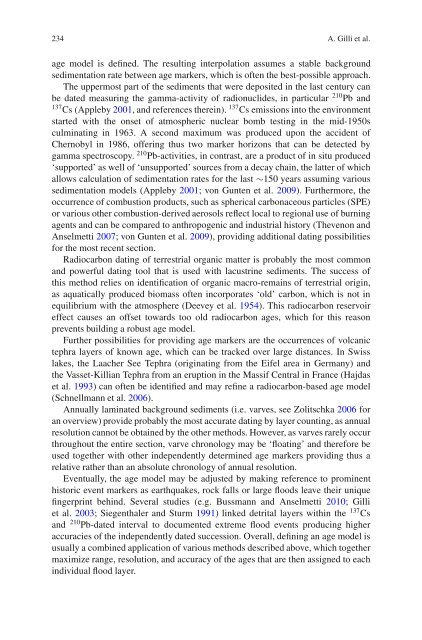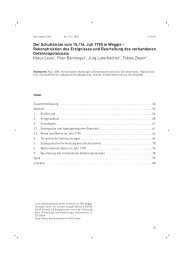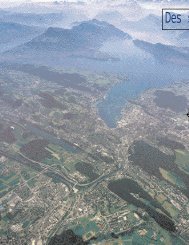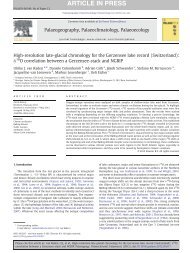Lake Sediments as Archives of Recurrence Rates and ... - Eawag
Lake Sediments as Archives of Recurrence Rates and ... - Eawag
Lake Sediments as Archives of Recurrence Rates and ... - Eawag
You also want an ePaper? Increase the reach of your titles
YUMPU automatically turns print PDFs into web optimized ePapers that Google loves.
234 A. Gilli et al.<br />
age model is defined. The resulting interpolation <strong>as</strong>sumes a stable background<br />
sedimentation rate between age markers, which is <strong>of</strong>ten the best-possible approach.<br />
The uppermost part <strong>of</strong> the sediments that were deposited in the l<strong>as</strong>t century can<br />
be dated me<strong>as</strong>uring the gamma-activity <strong>of</strong> radionuclides, in particular 210 Pb <strong>and</strong><br />
137 Cs (Appleby 2001, <strong>and</strong> references therein). 137 Cs emissions into the environment<br />
started with the onset <strong>of</strong> atmospheric nuclear bomb testing in the mid-1950s<br />
culminating in 1963. A second maximum w<strong>as</strong> produced upon the accident <strong>of</strong><br />
Chernobyl in 1986, <strong>of</strong>fering thus two marker horizons that can be detected by<br />
gamma spectroscopy. 210 Pb-activities, in contr<strong>as</strong>t, are a product <strong>of</strong> in situ produced<br />
‘supported’ <strong>as</strong> well <strong>of</strong> ‘unsupported’ sources from a decay chain, the latter <strong>of</strong> which<br />
allows calculation <strong>of</strong> sedimentation rates for the l<strong>as</strong>t 150 years <strong>as</strong>suming various<br />
sedimentation models (Appleby 2001; von Gunten et al. 2009). Furthermore, the<br />
occurrence <strong>of</strong> combustion products, such <strong>as</strong> spherical carbonaceous particles (SPE)<br />
or various other combustion-derived aerosols reflect local to regional use <strong>of</strong> burning<br />
agents <strong>and</strong> can be compared to anthropogenic <strong>and</strong> industrial history (Thevenon <strong>and</strong><br />
Anselmetti 2007; von Gunten et al. 2009), providing additional dating possibilities<br />
for the most recent section.<br />
Radiocarbon dating <strong>of</strong> terrestrial organic matter is probably the most common<br />
<strong>and</strong> powerful dating tool that is used with lacustrine sediments. The success <strong>of</strong><br />
this method relies on identification <strong>of</strong> organic macro-remains <strong>of</strong> terrestrial origin,<br />
<strong>as</strong> aquatically produced biom<strong>as</strong>s <strong>of</strong>ten incorporates ‘old’ carbon, which is not in<br />
equilibrium with the atmosphere (Deevey et al. 1954). This radiocarbon reservoir<br />
effect causes an <strong>of</strong>fset towards too old radiocarbon ages, which for this re<strong>as</strong>on<br />
prevents building a robust age model.<br />
Further possibilities for providing age markers are the occurrences <strong>of</strong> volcanic<br />
tephra layers <strong>of</strong> known age, which can be tracked over large distances. In Swiss<br />
lakes, the Laacher See Tephra (originating from the Eifel area in Germany) <strong>and</strong><br />
the V<strong>as</strong>set-Killian Tephra from an eruption in the M<strong>as</strong>sif Central in France (Hajd<strong>as</strong><br />
et al. 1993) can <strong>of</strong>ten be identified <strong>and</strong> may refine a radiocarbon-b<strong>as</strong>ed age model<br />
(Schnellmann et al. 2006).<br />
Annually laminated background sediments (i.e. varves, see Zolitschka 2006 for<br />
an overview) provide probably the most accurate dating by layer counting, <strong>as</strong> annual<br />
resolution cannot be obtained by the other methods. However, <strong>as</strong> varves rarely occur<br />
throughout the entire section, varve chronology may be ‘floating’ <strong>and</strong> therefore be<br />
used together with other independently determined age markers providing thus a<br />
relative rather than an absolute chronology <strong>of</strong> annual resolution.<br />
Eventually, the age model may be adjusted by making reference to prominent<br />
historic event markers <strong>as</strong> earthquakes, rock falls or large floods leave their unique<br />
fingerprint behind. Several studies (e.g. Bussmann <strong>and</strong> Anselmetti 2010; Gilli<br />
et al. 2003; Siegenthaler <strong>and</strong> Sturm 1991) linked detrital layers within the 137 Cs<br />
<strong>and</strong> 210 Pb-dated interval to documented extreme flood events producing higher<br />
accuracies <strong>of</strong> the independently dated succession. Overall, defining an age model is<br />
usually a combined application <strong>of</strong> various methods described above, which together<br />
maximize range, resolution, <strong>and</strong> accuracy <strong>of</strong> the ages that are then <strong>as</strong>signed to each<br />
individual flood layer.








